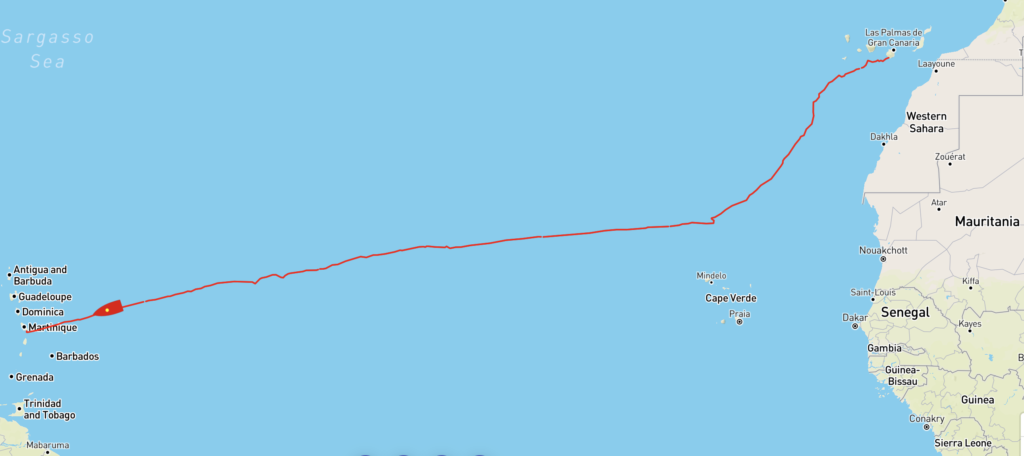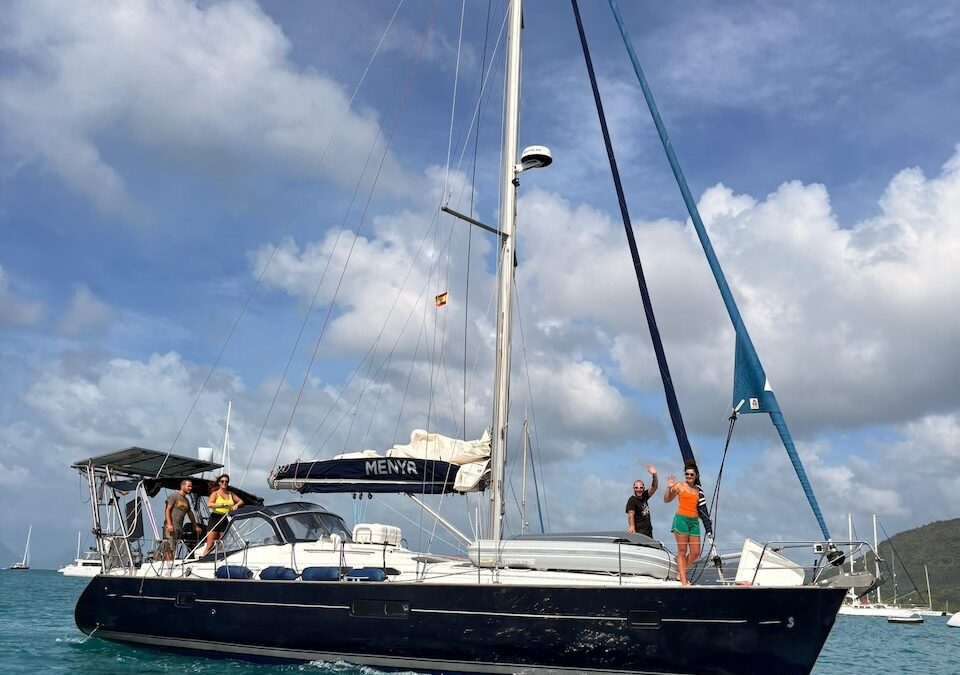Friday 20 December 2024, it’s three weeks since we left the Canaries and we still have 40 hours of sailing to do before we drop anchor in Martinique.
The mood aboard Menyr is great, with the trade winds pushing her along at between 6 and 8 knots. Today is similar to yesterday, with blue skies dotted with cumulus clouds, although the weather forecast was for lightning. Yesterday it was wrong too. We arrive soon, we still have fresh vegetables, charcuterie, about 200L of drinking water in our tanks and ¾ of the diesel tank. We’ve done pretty well so far!
There are 4 of us on board, Morgane, Joris, Raquel and me. The night is divided into 5 shifts: 6pm-10pm, 9pm-1am, midnight-4am, 3am-7am and 6am-10am. One of us does the first and last watches, so we’re always on the lookout. If the wind changes or anything else requires my intervention, the crew member on watch comes to wake me up. As skipper, I don’t have quite the same rhythm, as my attention is focused on steering the boat and getting us to port in the best possible conditions.
From today’s perspective, Gran Canaria seems as far away geographically as it did back in the day. It must be said that it’s been three weeks to the day since our departure and we’ve covered 2500 nautical miles since then! The days are similar, yet different. We’re still on the sea, sometimes with clouds, sometimes without, the swell changes a little and so does the wind, but overall the changes are subtle.

Week 1, the descent into the trade winds
When you think back to the first week, the psychological landscape is completely different. We’re still on Menyr, on the ocean downwind, but even though we can’t see them any more, we can feel the Canaries close behind us, Africa to port and Cape Verde straight ahead.
This first week was very difficult for me, as from the first evening we didn’t have the wind forecast in the bulletin. I would have liked to have headed west from the Canaries without getting too close to Cape Verde in order to reduce the distance to cover. But the weather decided otherwise, with a large storm zone blocking our path along the whole western part of the Canaries – Cape Verde route. So we opted for a standard route: taking the southern ramp towards Cape Verde, which takes us onto the trade winds’ motorway.

I did a lot of manoeuvring day and night, virtually on my own, as the crew didn’t know the boat well enough yet. I quickly got tired of the pace, the routing choices stressed me out and we still had a few things to sort out that we hadn’t been able to do before we lifted anchor. Like jigsawing plywood in the middle of the ocean to make the support for the 8kg Iberian ham we’d bought the day before departure..
All the same, the routine has settled in quite easily. Every evening at midnight we start a new page in the logbook. Among other things, we fill in the levels of the three fresh water tanks. On the fourth day, we found that the 200 liter tank was only 40% full, whereas it had been 95% full the day before, so we lost 100 litres in just a few hours! It didn’t take long to realise that we hadn’t turned off the tap to the outside shower. By putting the shower head back in its place, it’s easy to let a trickle of water run out. That’s how the boat both emptied and filled up with our precious fresh water! It’s infuriating when you consider that I installed this tap a month ago precisely to prevent this leak.
In the end, we found a downwind which enabled us to get closer to Cape Verde while watching the lightning far to the west throughout the week. We caught a dolphinfish, which we were delighted to eat, saw few freighters and only two sailing boats. Time already seems a long time, we’re getting closer and closer to Cape Verde, we can’t wait to turn to starboard and finally benefit from the famous trade winds heading straight for the Caribbean!
Little did we know at the time that we’d be greeted by our friend the Arcus!

Week 2, surprise around the bend!
As we headed west to the north of Cape Verde, we had our first thunderstorms on the night of Thursday 12 to Friday 13 December. We could see them on the screen of our brand new radar: they form quickly and move by turning to the right under the effect of the Coriolis force. Seeing their trajectory we slalomed between them all night. Squalls are all around, and so are their lightning bolts. Towards the end of the night one of them formed to our south-east, and in no time it became so colossal that the radar screen was completely red even though it covered 24 nautical miles! In short, we only avoided the most active part of it and managed to stay relatively far away as best we could. Raquel and Joris and I admired the zebras of lightning quickly followed by the crashing thunder. It’s a wonderful sight, but one that I always find disturbing when you’re the only metal mast in the vastness of the ocean.
Happy to have passed these stormy episodes all night long, I went to bed after sunrise. 20 minutes later the noises of the boat woke me up and Morgane announced a wind shift of 120 degrees. A few moments later she announced a ‘grey’ horizon and indeed a beautiful Arcus was rushing towards us. An arcus is a scroll-shaped cloud at the base of a very active cumulonimbus, so it’s not exactly a harbinger of good weather! It passed over us, the wind picked up to 40 knots and the swell was transformed into magnificent blue dunes by the deluge of rain combined with the strong wind. We delighted at the spectacle for a few short minutes, then tried to head south to get out under engine, but it was completely useless! We shut ourselves inside and waited all sails down in total discomfort. Morgane, oblivious to the movements of the boat as it churned in the storm, cooked us some pasta with chorizo!
After a four hours’ rest, I take stock of the situation with the crew. The weather report I had indicated a few storms but not a wind shift of almost 180 degrees for half the day. The boat was soaked by the storm and upside down. I decided to contact our shore contact to find out if there was a more global weather phenomenon taking place that I couldn’t see with my little Garmin InReach, which wasn’t giving us the general situation. While we waited for his reply, we headed for Mindelo in Cape Verde, where we could recover the 100 litres of fresh water we’d lost earlier and clean and dry the boat. We’re at the point of no return: if we head for the Caribbean now, there’s no turning back! On the way we took stock of the situation more accurately, calculated that we had more than enough water to cross and received the full weather report, which was favourable for crossing.

We then set a course of 270 towards Martinique, and that’s how the second week began!
That’s it! We’ve finished setting off for good, Africa is at our backs and we’re on our way to the Caribbean!
We made rapid headway downwind in the 20-25 knot trade winds. With just the spinnaker genoa, which we furled and unfurled according to the strength of the wind, we were reaching an average speed of 5 knots, with Menyr rolling hard in the 2 to 3 metre waves. After a couple of days like that I redid my calculations and realised that we’d make it to Christmas at this pace – it was time to start sailing for real and get the boat moving on. With the staysail and the spinnaker genoa we were able to increase our average speed to over 6 knots, with peaks of 8-9 knots. The ETA will be back around 22 December, much better!
Week 3: the beginning of the end

This is it! We had set an imaginary point in the middle of the Atlantic which we called ‘Midway’, nothing to do with the historically famous island in the Pacific. Before we reached it we were leaving, now that we’ve passed it we’re arriving. Psychologically, it changes a lot of things!
Just before reaching it, we came across a French catamaran that we’d met in Las Palmas de Gran Canaria. It was the first sailing boat we’d seen in 10 days. The flying fish are still crashing on the deck every night! We haven’t had a single bite since we lost our big bate. Apparently deep-sea fish like big lures, but we’re moving too fast for the smaller ones.

Just as we were passing ‘Midway’, a piece of fishing net got stuck in our propeller. To her great delight, Morgane went to unhook it and took the opportunity to swim in the middle of the ocean!
On my side I wasn’t really in great shape. The weather forecast predicted very little wind for the rest of the crossing and lots of thunderstorms. I was worried about spending the last week of the crossing manoeuvring all the time to make use of the little wind, juggling between the squalls to be able to make our way. I wanted to arrive.
In the end the wind was there, much to my delight, and we made almost direct route, averaging over 6 knots during the day. The sky is very surprising, with small cumulus clouds forming here during the day, and sometimes stratus clouds covering the sky and preventing our solar panels from compensating for our electricity consumption. In the evening at sunset, the clouds all disappear in no time. A few minutes later the cloud layer returns and hides the stars as quickly as it disappeared, 2 minutes 3 at the most, it’s very surprising. The squalls formed just as quickly but were not violent, some giving us a little rain and causing the wind to change slightly, but overall the conditions were very comfortable for moving forward, and quickly.







Conclusion
We spent the whole year preparing Menyr for our round-the-world trip. We had the rigging redone and upgraded, removed the teak from the deck, fitted a stainless steel stern arch with new solar panels, redid the electrical circuit, changed some instruments, sandblasted the hull, carried out very advanced maintenance on almost all the boat’s systems, re-varnished and built some furnitures. I have a few drafts of blog posts detailing this work, but I haven’t found the time to finish them or publish them. With this pace and working full time, Raquel and I were overworked when Morgane and Joris arrived.
The last-minute joke was the delivery of our windvane gear, which was held up by customs. Ordered six months in advance, we received it the day after the crew arrived. It cost us three days to install, precious time that we could have used for other things. For example, building the jamòn stand, enjoying the last few moments ashore, etc.
In the end, we’ve achieved our goal of crossing this year with a ready boat. Even though our preparation with Raquel has been painful, we’re very proud of what we’ve achieved in such a short space of time.
We’re ready to make the most of the Caribbean!


